Photographers with prosthetics need specialized gear for stability and control. Consider the Amp-U-Pod, which attaches directly to prosthetic devices, or cameras with adjustable grip sizes and remote triggers for hands-free operation. Lightweight equipment reduces strain during extended sessions, while quick-release mounting systems allow fast switching between accessories. Don’t overlook weatherproof covers like DRYPRO to protect your prosthetic while shooting. The right adaptive equipment can transform your unique perspective into stunning imagery.
Understanding the Unique Needs of Photographers With Prosthetics
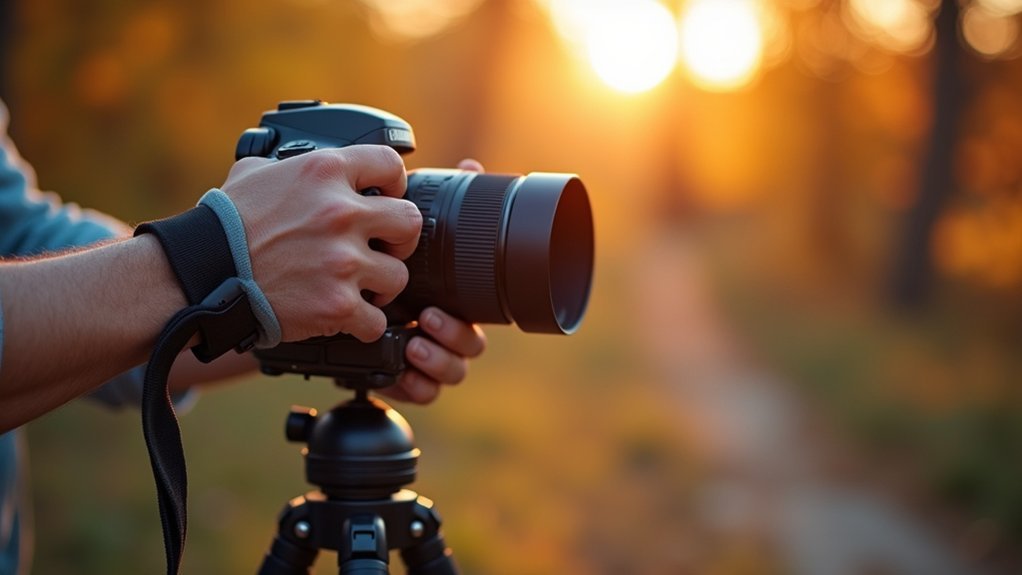
Innovation in adaptive photography has opened new doors for prosthetic users seeking to explore their creative vision.
Innovation empowers prosthetic photographers to capture their unique perspective without technical barriers.
When considering equipment that works for you, stability and control are paramount challenges to address. Prosthetic-friendly cameras feature adaptive handles with adjustable grips that accommodate various hand types and sizes.
You’ll find that lightweight designs reduce strain during extended shooting sessions, while specialized mounts minimize unwanted movement.
Control interfaces matter too—look for intuitive systems that don’t require complex manipulation of small buttons or dials.
The best equipment adapts to your specific prosthetic rather than forcing you to adapt to the camera.
Consider devices with electrical trigger activation mechanisms and feedback systems that provide tactile responses, enhancing your ability to capture the perfect shot. Some advanced systems use electrical impulses to automatically trigger the shutter when optimal composition is detected.
Camera Mounting Options for Prosthetic Arms and Hands
When choosing camera equipment for your prosthetic setup, specialized socket attachments offer secure integration between your device and photography gear.
Quick-release mounting systems allow you to switch between cameras or accessories without frustrating readjustments, saving valuable time during shoots.
Adjustable grip solutions provide customizable handling options that can be tailored to your specific prosthetic configuration, ensuring comfortable control during extended photography sessions. For optimal compatibility and alignment of your photography equipment, consider seeking recommendations from certified prosthetists who are familiar with integrating TRS products with specialized equipment.
Specialized Socket Attachments
Photography enthusiasts with prosthetics now have access to specialized socket attachments that transform their devices into versatile camera mounts. These attachments are engineered for compatibility with various prosthetic models while ensuring stability for your equipment. The approach mimics arm-mounted cameras which provide optimal viewing capabilities by adjusting distance for the perfect shot.
| Feature | Benefit |
|---|---|
| Adjustable Fittings | Accommodates different camera sizes |
| Durable Materials | Withstands daily use and outdoor conditions |
| Quick-Release Systems | Allows fast switching between equipment |
You’ll find most socket attachments offer customization options to match your specific prosthetic design. The best models include safety features that prevent accidental drops while maintaining ease of use. When selecting an attachment, consider both weight capacity and ergonomics—your comfort during extended photography sessions is essential for capturing those perfect shots.
Quick-Release Mounting Systems
For photographers with prosthetics, quick-release mounting systems represent a game-changing advancement that transforms shooting capabilities.
These systems offer secure, stable mounting options while allowing quick camera attachment and detachment—crucial when working with prosthetic arms.
Arca-style systems provide exceptional flexibility with side-to-side adjustments and compatibility with L-brackets.
Though setup isn’t the fastest, their reliability and secure hold deliver confidence during shoots.
You’ll find these systems compatible with various camera models including Canon, Sony, and RED.
Many include universal thread attachments and secondary safety locks to prevent accidental releases.
For precise control, options like the Manfrotto Magic Arm lock multiple pivot points.
The Quick Release Mini Monitor Mount provides additional functionality with its specialized design for Magic Arm compatibility, perfect for prosthetic users who need accessible monitor viewing.
These user-friendly systems ultimately enhance your efficiency, stability, and independence—empowering you to focus on creativity rather than equipment struggles.
Adjustable Grip Solutions
Adjustable grip solutions expand beyond quick-release systems to address the unique mounting needs of photographers with prosthetics.
Products like the AMP-u-POD, designed by an amputee photographer, offer modularity that adapts to various cameras and prosthetic arms.
You’ll find these mounts integrate seamlessly with standard camera fittings using 1/4″-20 hot shoe connections while providing lockable tripod mounts for secure positioning.
The user-centric design accommodates different grip styles and preferences, enhancing your shooting experience.
For more advanced options, consider adaptable industrial mounting solutions or even robotic arms like the myCobot 320, which enable precise camera movements and unique angles. The latest robotic arm options feature modular design for versatile placement and quick setup to accommodate different photography sessions.
These durable systems withstand regular use in varying environments, giving you the flexibility to customize your setup based on your specific prosthetic configuration and photography requirements.
Specialized Tripods and Stabilization Systems
You’ll find specialized stabilization systems like the Amp-U-Pod and adaptive mounts that connect directly to your prosthesis for superior camera control.
These mounting systems offer essential stability for achieving professional-quality images, especially during longer exposures or in challenging environments. Professional-grade options like those from Really Right Stuff’s Versa Mk2 series provide the rugged construction and vibration minimization that’s crucial for prosthetic users.
Many tripods now feature one-handed setup options with quick-release plates and ergonomic designs specifically engineered for prosthetic users who need efficiency and independence in their photography workflow.
Subheading Discussion Points
When selecting a tripod system, prosthetic users face unique challenges that standard equipment doesn’t always address.
Lightweight options made from aluminum or carbon fiber offer the ideal balance of durability and portability, with models under 7 lbs reducing physical strain.
Look for flip-lock mechanisms rather than twist locks, as they’re easier to manipulate with prosthetic limbs. Quick-release plates and ball heads with smooth friction controls minimize the dexterity required for adjustments.
If you need enhanced mobility, consider hybrid solutions like convertible tripod-monopod systems. Models like the Manfrotto BeFree Compact Travel Tripod provide excellent stability and portability while remaining accessible for prosthetic users.
For customized support, specialized adaptations like the Amp-U-Pod can directly integrate with your prosthetic terminal.
These purpose-built options allow for secure camera handling while accommodating your specific needs and shooting style.
Mounting Systems For Stability
Beyond standard tripods, specialized mounting systems offer prosthetic photographers unparalleled stability advantages. The Amp-U-Pod, designed specifically for prosthetic users, fits directly into your prosthetic device, creating a stable platform for your camera.
When selecting a tripod, look for models with even weight distribution and adjustable legs for uneven terrain. Carbon fiber options provide durability without excessive weight. Consider the Befree Collection designed for professionals, which offers lightweight and portable options ideal for photographers with prosthetics who need enhanced mobility.
For enhanced stability, consider tripods with geared center columns that allow precise height adjustments. Stabilization systems with vibration reduction technology help you capture sharper images, especially in challenging lighting conditions.
Many feature ergonomic handles that can be adapted for your prosthetic device. The best systems integrate seamlessly with your prosthesis while providing customizable options to accommodate your specific photography needs and physical requirements.
One-Handed Setup Options
Photographers with prosthetics face unique challenges when setting up equipment, making one-handed operation essential for independence and efficiency. Specialized tripods with ball heads and flip-lock leg systems allow for quick, single-handed adjustments while maintaining stability. Quality tripods are a worthy investment decision, preventing additional costs and frustrations in the long run.
| Feature | Benefit |
|---|---|
| Ball heads | One-handed camera positioning with 360° rotation |
| Flip-lock legs | Quick setup without complex adjustments |
| Quick release plates | Fast camera attachment/detachment |
| Rapid center columns | Instant height adjustments on the go |
Look for Arca-compatible quick release systems that let you attach your camera with minimal effort. Manfrotto’s 055 collection offers aluminum options that balance durability with weight, while carbon fiber alternatives provide enhanced stability in various conditions without adding bulk to your kit.
The Amp-U-Pod and Other Dedicated Prosthetic Accessories
Among the most revolutionary tools for prosthetic photographers, the Amp-U-Pod stands out as a game-changer. This lightweight aluminum device weighs just 2.5 oz and features a non-glare black finish to reduce unwanted reflections during shoots.
You’ll appreciate how the Amp-U-Pod fits directly into your prosthetic, replacing standard terminal devices while offering enhanced camera control. Its lockable tripod mount secures your camera at various angles, giving you stability and flexibility for creative shots.
Compatible with any camera using the standard 1/4″-20 hole fitting, this accessory greatly improves your independence and confidence. Instead of struggling with conventional equipment, you can focus on your creative vision while enjoying improved accessibility and handling.
For detailed information and specifications about this and other specialized devices, you can browse through Fillauer’s comprehensive product library designed for users with specific needs.
These dedicated accessories ultimately allow you to pursue photography without limitations.
Adapting Standard Camera Equipment for Prosthetic Users
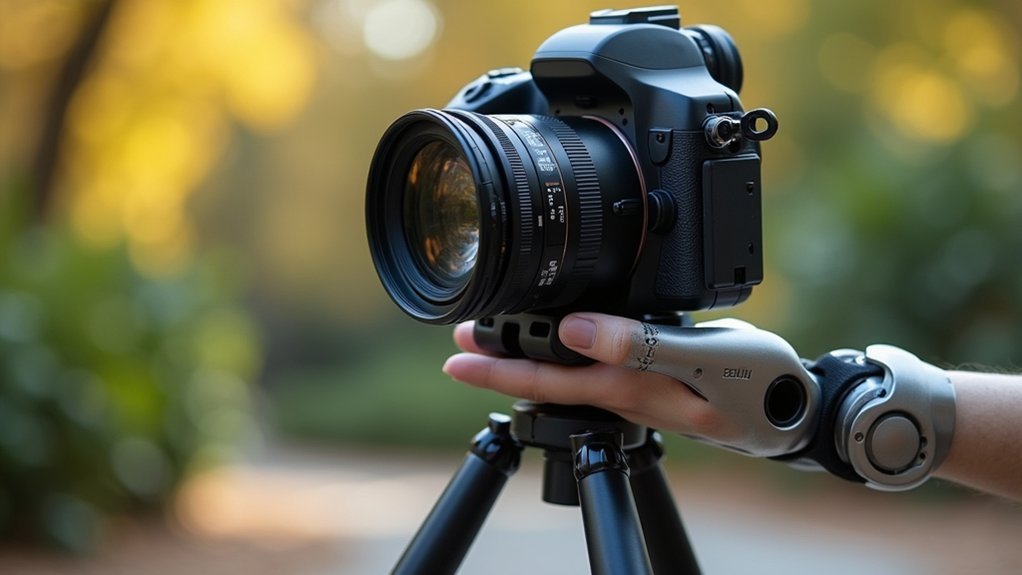
While specialized accessories like the Amp-U-Pod offer excellent solutions, standard photography equipment can also be effectively modified to meet your needs as a prosthetic user.
Consider adapting equipment handles with rubber or foam materials for enhanced grip comfort and control. Look for cameras with adjustable grip sizes to accommodate your specific prosthesis configuration.
Customize your grip interface for maximum comfort—the right adaptation transforms challenging camera control into intuitive photography.
For mounting systems, seek options with versatile attachment points and quick-release mechanisms that simplify setup with limited dexterity. Recent research into prosthetic robots has emphasized the importance of adaptable control systems for real-world applications beyond laboratory environments.
Tripods and monopods provide essential stability, reducing fatigue during extended shooting sessions. Weight management is essential—lighter equipment minimizes strain on your prosthetic limb.
Don’t overlook the potential of 3D printing for creating custom accessories tailored to your prosthetic’s unique shape.
These modifications can be cost-effective while providing seamless integration with your existing equipment.
Grip Solutions and Shutter Control Mechanisms
When you’re using a prosthetic hand for photography, stabilizing mounts can provide the steadiness you need for crisp, clear images.
Remote trigger technologies offer you hands-free options to capture the perfect shot without pressing physical buttons.
Cameras with customizable button layouts allow you to reconfigure controls based on your specific grip capabilities and preferences.
For users with partial hand loss, the i-Digits Quantum prosthetic system offers gesture-based technology that can be particularly effective for controlling camera functions.
Stabilizing Mounts for Steadiness
For photographers with prosthetic limbs, achieving stability can present unique challenges that require specialized equipment. When choosing mounts, look for adaptive options that accommodate your specific prosthetic configuration while providing maximum stability. Many prosthetic users can benefit from electric feedback systems similar to those used in Buczkowski’s Prosthetic Photographer device.
| Mount Type | Best For | Key Feature |
|---|---|---|
| Tripods with Adaptors | Studio work | Secure attachment points |
| Forearm Mounts | On-the-go shooting | Body-supported stability |
| Amp-U-Pod | Standard equipment | Simple grip solution |
Consider weight distribution systems that balance your camera’s weight evenly across your prosthetic, reducing strain and improving control. Adjustable clamps with anti-slip materials can greatly enhance your grip security, while compensatory balance mechanisms help offset any weight disparities caused by your prosthetic configuration. The right mount will transform your photography experience by minimizing camera shake.
Remote Triggers Technologies
Remote trigger technologies offer a transformative solution for prosthetic users who struggle with traditional camera operation. These systems use radio, infrared, or Bluetooth signals to activate your camera shutter without physical contact.
Specialized options like the Amp-U-Pod fit directly into prosthetic terminal devices, providing reliable control. You’ll find wireless triggers that can be activated by pressure pads or buttons positioned where you have ideal control.
For maximum flexibility, consider radio-frequency triggers with hundreds of feet of range. Many triggers now feature customizable button size, resistance, and feedback mechanisms tailored to prosthetic capabilities. The Elinchrom EL-Skyport Transmitter Plus offers exceptional range with control capabilities for flash units up to 656 feet away.
Some integrate with smartphone apps or voice control systems for hands-free operation. When selecting a trigger, prioritize compatibility with your specific camera model and prosthetic limitations.
Customizable Button Layouts
Customizable button layouts represent the next frontier in accessible photography equipment for prosthetic users. Luxury options like the Leica Lux Grip offer mechanical two-stage shutter buttons with enhanced tactile feedback, essential when you’re using prosthetics with limited sensory feedback. These grips feature ambidextrous designs to accommodate both left and right-handed users. Mounting a quick-release plate on a prosthetic arm provides an innovative solution for stability and camera control.
| Feature | Benefit | Prosthetic Application |
|---|---|---|
| Two-stage shutter | Improved tactile feedback | Better control with limited sensation |
| Assignable FN buttons | Personalized workflow | Reduces need for complex movements |
| Ambidextrous layout | Universal accessibility | Works with any prosthetic setup |
| Tripod threads | Added stability options | Reduces fatigue during extended use |
| Mechanical controls | Traditional camera feel | Minimal learning curve for experienced photographers |
You’ll find these customizable interfaces particularly valuable when shifting between different shooting environments or when your prosthetic requires specific accommodations.
Bionic Hand Technology With Integrated Camera Functionality
Revolutionary advancements in prosthetic technology have emerged through the integration of miniature cameras within bionic hands, transforming how users interact with their environment.
These cameras capture instant images of objects you’re about to grasp, automatically determining ideal grip patterns through real-time processing.
For photography enthusiasts, this technology offers unique advantages. The AI-driven systems learn your specific shooting preferences, enhancing movements for camera handling.
Combined with myoelectric sensors, you’ll experience intuitive control when adjusting settings or changing lenses. These sensors can detect the smallest biological movements to improve functionality when operating camera equipment. The multisensory feedback provides tactile responses when handling delicate photography equipment.
You’ll appreciate reduced cognitive load during shoots as your prosthetic automatically adapts to different camera bodies, lenses, and accessories.
Despite current challenges with power consumption, this technology markedly enhances accessibility and autonomy in photography.
Remote Control and Wireless Trigger Systems
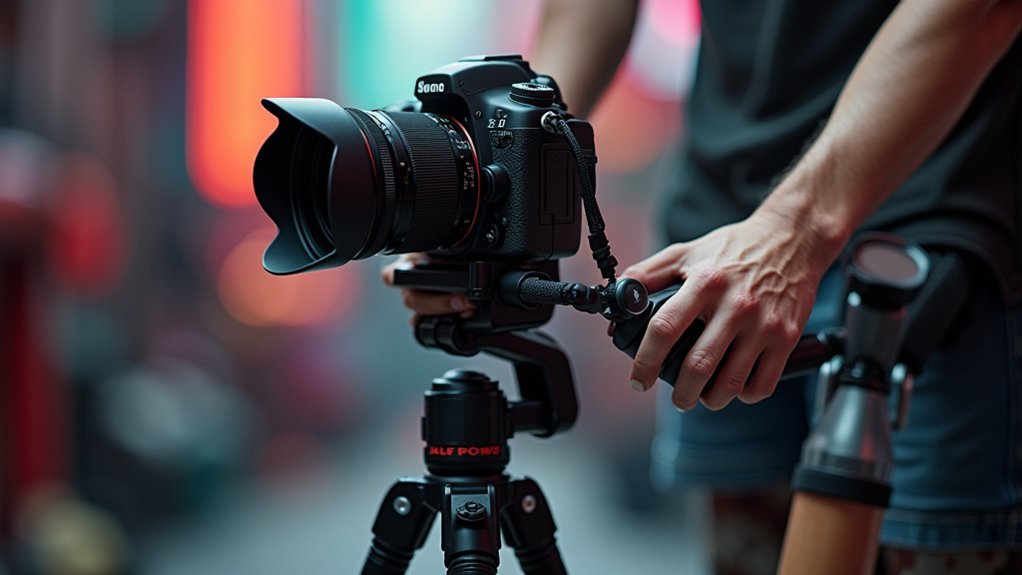
Beyond the advancements in bionic hand technology, wireless trigger systems offer prosthetic users unprecedented control and flexibility in their photography pursuits. You’ll find numerous options that integrate seamlessly with your prosthetic, enabling independent camera operation without pressing physical buttons. For users with prosthetic hands, these systems can be complemented with accelerometer sensors to detect specific hand movements and gestures for camera control.
| Trigger Type | Benefits | Best For |
|---|---|---|
| Bluetooth/RF | Broad compatibility, reliable connection | General photography |
| Touch-activated | Minimal force required, high sensitivity | Limited dexterity |
| Voice/Motion | Hands-free operation, gesture control | Complex shooting scenarios |
When selecting a trigger system, prioritize lightweight designs with tactile feedback and adjustable mounting options. Look for devices that communicate with low latency and offer customizable sensitivity. These features reduce fatigue during extended shoots while allowing you to capture spontaneous moments with precision. Many systems now work with both smartphones and DSLRs, expanding your creative possibilities.
AI-Assisted Photography Tools for Enhanced Accessibility
While mastering photography with prosthetics presents unique challenges, AI-assisted tools are transforming the landscape for adaptive photographers.
You’ll find customizable interfaces that adapt to your capabilities, using gesture recognition or voice commands to execute functions without physical manipulation.
Smart cameras now offer real-time composition guidance, auto-cropping, and stabilization features that compensate for unsteady movements.
Modern AI cameras intelligently guide, crop and stabilize—eliminating barriers for photographers with mobility challenges.
These systems interpret your prosthetic signals to control zoom, focus, and exposure with minimal effort.
The latest editing platforms automate retouching and organization tasks, reducing manual dexterity requirements.
For advanced users, next-generation prosthetics with embedded sensors can interface directly with cameras, providing haptic feedback and augmented reality overlays for precise framing.
These AI solutions learn your preferences over time, continuously improving accessibility and creative control. However, users should be aware that AI tools can sometimes produce ableist biases when generating content or recommendations for disabled photographers.
Weatherproof and Durable Equipment Considerations
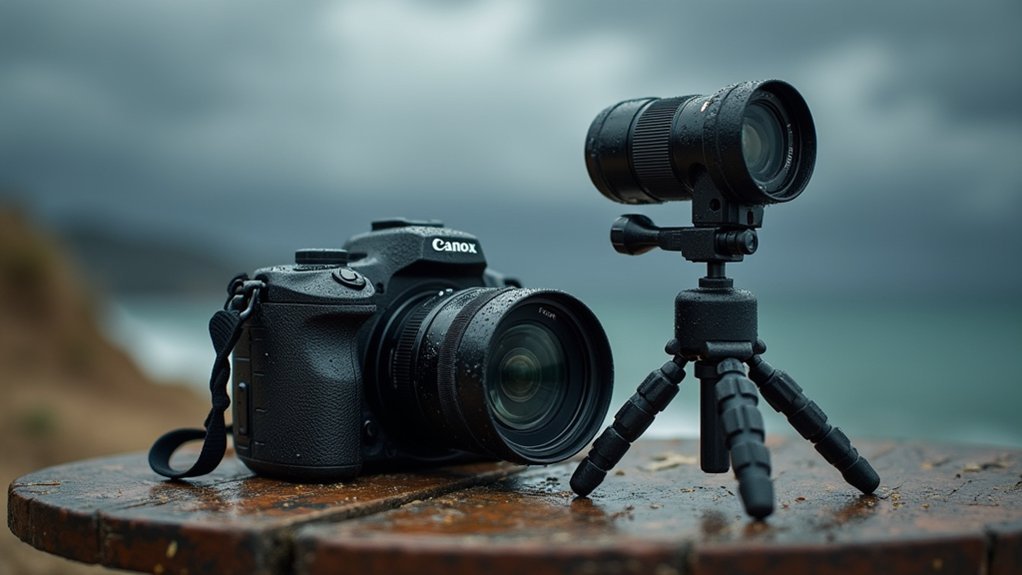
Photography in challenging environments demands gear that can withstand the elements, especially for prosthetic users who face unique handling considerations. Invest in weather-sealed cameras and lenses that provide protection against rain and dust while maintaining operational ease.
For prosthetic-specific solutions, consider the Amp-U-Pod or specialized terminal devices designed to securely hold your equipment. When shooting near water, DRYPRO waterproof prosthetic covers with vacuum seals will protect your prosthesis while allowing full mobility.
Don’t overlook stability accessories—premium tripods with quick-release plates, monopods, or flexible GorillaPods can compensate for potential grip challenges. Users with upper limb prosthetic devices, including myoelectric hands, can benefit from camera equipment with customizable button layouts for easier operation.
Keep lens cleaning kits and microfiber cloths handy to maintain superior image quality in harsh conditions. Weatherproof cases will guarantee your gear remains protected during transport between shooting locations.
Budget-Friendly Adaptive Photography Solutions
Pursuing photography shouldn’t require breaking the bank, especially for prosthetic users seeking accessible equipment. Cost-effective solutions can provide both functionality and comfort without sacrificing quality.
Consider these affordable options:
- Camera control apps with VoiceOver features allow smartphone photography with minimal physical interaction for around $5-10.
- Tethered shooting connects your camera to a computer, enabling easier control through larger screens and mouse clicks.
- Eneloops rechargeable batteries ($20) and macro extension tubes (under $20) offer practical photography solutions at minimal cost.
- Assistive devices like adapted switches with larger buttons accommodate prosthetic users while remaining budget-friendly.
These solutions integrate well with prosthetic care routines and won’t interfere with daily maintenance needs. Remote controls with tactile response differences can be selected based on your specific Canon camera model and prosthetic requirements.
Success Stories: Professional Photographers Using Prosthetics
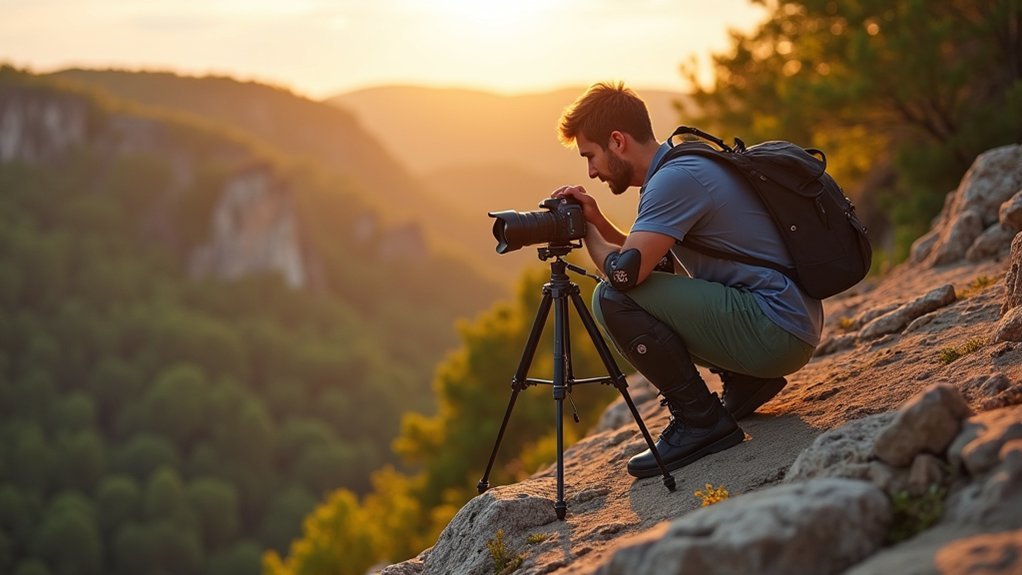
Numerous successful photographers with prosthetics have shattered conventional limitations, proving that limb differences need not impede artistic vision or professional achievement.
Giles Duley, a one-armed war photojournalist, shifted from fashion photography to documenting marginalized communities, contributing authentically to disability narratives without tokenism.
The photography world is increasingly celebrating amputee creatives, like the double amputee who recreated Cinderella’s iconic scene with her prosthetic arm.
Child double-amputee Daisy-May Demetre’s appearance at New York Fashion Week further exemplifies the growing visibility of prosthetic users in creative fields.
Behind these successes stands essential support from prosthetic service providers who customize solutions for photographers’ unique needs.
Their responsive care enables professionals to handle equipment effectively, building on innovations pioneered by historical figures like James E. Hanger.
Many photographers with prosthetics find ways to adapt their equipment and techniques, with some even discovering that a lighter equipment setup can actually improve mobility and reduce strain during recovery periods.
Emerging Technologies Shaping the Future of Adaptive Photography
The horizon of adaptive photography expands dramatically as cutting-edge technologies reshape possibilities for prosthetic users.
With AI-powered prosthetics adapting to your specific shooting style and neural interfaces enabling more intuitive camera control, you’ll find photography becoming increasingly accessible.
Four transformative technologies to watch:
- Haptic feedback systems that let you “feel” your camera settings and composition through your prosthetic
- Predictive learning algorithms that anticipate your photographic intentions based on previous shooting patterns
- Osseointegrated mounts providing stable, direct camera attachment to prosthetic limbs
- AR-enhanced viewfinders offering voice-controlled composition assistance and real-time guidance
These innovations bridge the gap between imagination and execution, allowing you to focus on creative vision rather than technical limitations. The most effective systems position these devices as collaborative partners rather than static tools, fostering greater engagement and confidence during photography sessions.
Frequently Asked Questions
How Does Cold Weather Affect Prosthetic Photography Gear Performance?
Cold weather drastically reduces your battery life, makes joints and controls stiffer, and increases difficulty gripping equipment. You’ll need insulated components and adaptive accessories to maintain dexterity when operating cameras with prosthetics.
Can Prosthetic Camera Mounts Be Used for Underwater Photography?
Yes, you can use prosthetic camera mounts underwater, but you’ll need special adaptations like waterproof sealing, corrosion-resistant materials, and buoyancy adjustments. Consider quick-release mechanisms for easy equipment handling during dives.
Are There Photography Courses Specifically Designed for Prosthetic Users?
While specialized photography courses for prosthetic users aren’t widely available yet, you’ll find more success through adaptive technology workshops, online communities sharing techniques, and general photography classes that can accommodate your specific needs.
How Long Do Camera-Integrated Prosthetic Hands Typically Last?
Camera-integrated prosthetic hands typically last 3-5 years, like most myoelectric prosthetics. You’ll find their lifespan depends on your usage patterns, maintenance habits, and the electronic components’ durability. Regular servicing extends their functionality.
Does Insurance Cover Specialized Photography Equipment for Prosthetic Users?
Insurance coverage for specialized photography equipment varies. Your private insurance might cover it with proper documentation, while Medicare and Medicaid typically don’t unless medically necessary. Veterans’ services and non-profits often provide better assistance.
In Summary
You’re part of an exciting evolution in photography where adaptive equipment is expanding accessibility. Whether you’ve chosen specialized mounts, custom tripods, or modified standard gear, your photography journey shouldn’t be limited by prosthetics. As technology advances, you’ll find even more innovative solutions emerging. Keep experimenting, connecting with the growing community of prosthetic photographers, and sharing your unique perspective with the world through your lens.

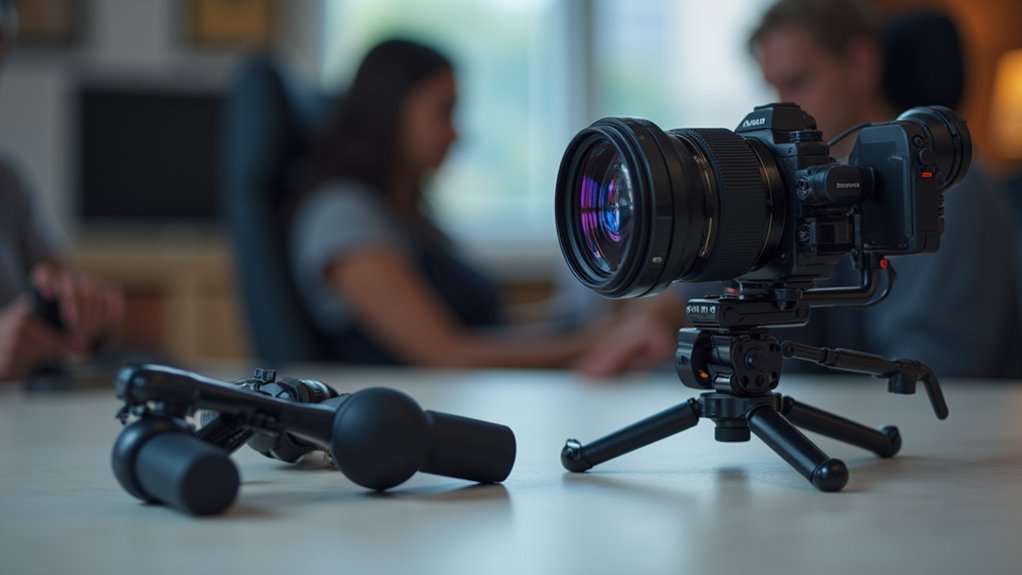



Leave a Reply